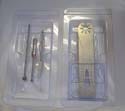July 14, 2004
OriginallyPublished MPMN July 2004PROFILE
Redesign Reduces Packaging Costs and Increases Safety
Clear, extrudable material is suitable for packaging surgical instruments
MelodyLee
|
Linvatec's surgical instruments are housed in a redesigned package incorporating Eastman Chemical's copolyester. |
Surgical instrument maker Linvatec (Largo, FL; www.linvatec.com)recently introduced a line of blades. However, the company knew it would need new packaging for its products since they feature sharp cutting edges that would most likely abrade and puncture the current thermoforms.
A new package had to be geared to consolidate old tray designs and suitably house the new blades along with the company's existing Hall Blade and Bur line, which are used in orthopedic surgical applications for the resecting of human tissue and bone. With the right material and the advice of packaging experts at Perfecseal (Oshkosh, WI; www.perfecseal.com), the finished product reduced costs by 16% and increased manufacturing capacity by 15%.
"We wanted to keep the tray as small as possible, but house a wide variety of parts," says Tara Martin, Linvatec's senior packaging engineer. "The new tray design needed to be compact to reduce the overall size of the carton."
Linvatec set the ground rule for Perfecseal that the new design must keep the same footprint as the old package. Other guidelines included being able to seal to the existing lid stock and meeting the same sterilization requirements.
"Linvatec wanted us to look at combining the current designs that used four different trays into one tray and one insert that would cover a line of 800 items," says Tad Kinyon, Perfecseal's project engineer. "With our new design, all the products use one tray. Approximately half the products require an additional insert for added protection."
Perfecseal chose Eastar copolyester 6763 by Eastman Chemical Co. (Kingsport, TN;www.eastman.com) to use in the packaging
redesign. Eastman's clear material passes shipping tests and gamma sterilization while keeping its clarity. With its toughness and melt strength, it is useful in sheet and film extrusion.
"Linvatec has always had such good results with Eastar copolyester 6763," says Martin. "We did not consider using anything else. Plus, our thermoformers find it easy to process. We were confident in Eastar's ability to maintain package integrity for the shelf life of the product."
According to Kinyon, all requirements of the material and the function of the trays were discussed with Linvatec. Knowing the sterilization method, material qualityspecifications, and the worldwide regulatory requirements, the copolyester was the obvious choice, he says.
The final design included an inner protective clamshell for the blades and an outer tray to house both the blades and burs. The inner portion was formed with an intricate interlocking grid pattern to stabilize the blades during shipping. Containing large blades, the clamshell provides a protective sheath around the sharp teeth, while the tray is a sterile barrier. The outer pouch of the previous design was eliminated to reduce stock.
"The design itself reduced the number of packaging items Linvatec needed to inventory," says Kinyon. "This results in cost savings in warehousing and reduced package costs due to purchasing trays in higher quantities. Combining five trays into one eliminated the need for additional setups of sealingequipment."
Copyright ©2004 Medical Product Manufacturing News
You May Also Like



